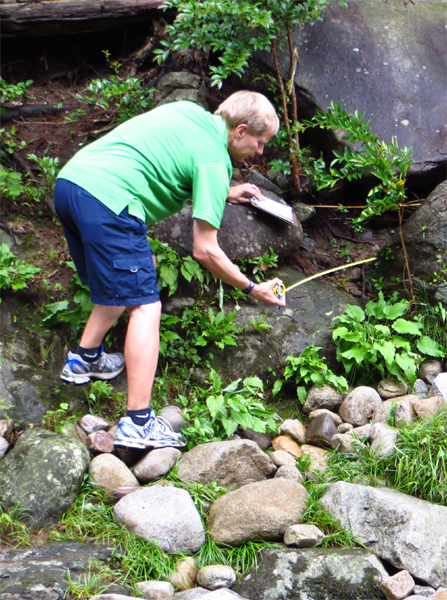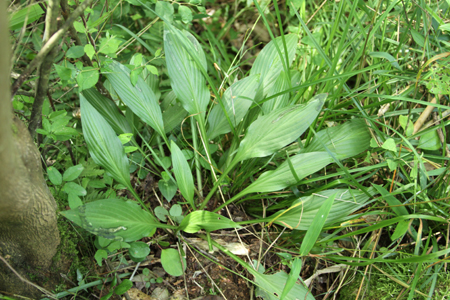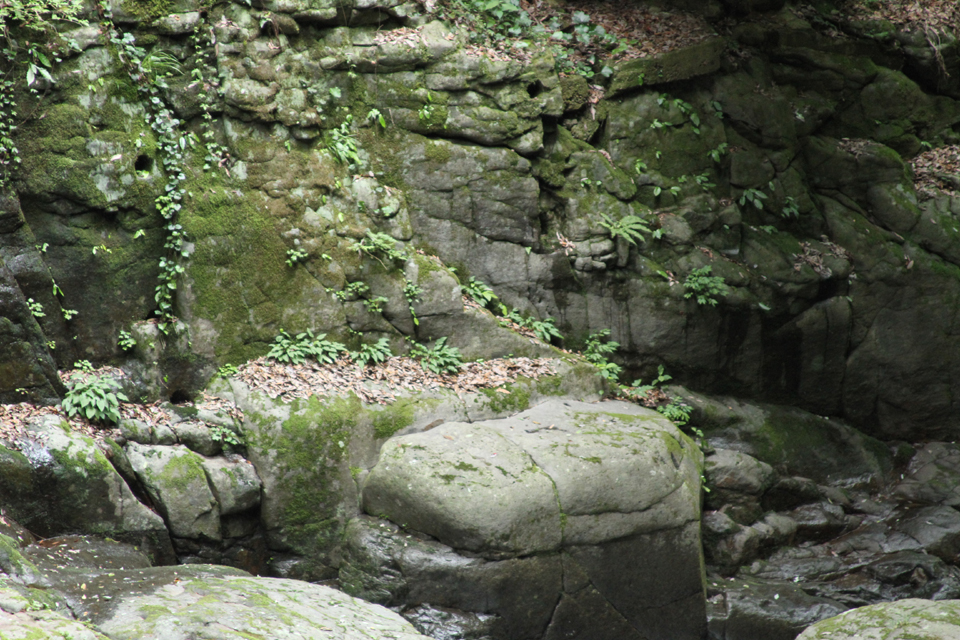 |
| Mark Zilis measuring Hosta kiyosumiensis in Japan |
Following the example of his grandfather, Mark developed a love for vegetable and flower gardening at an early age. During his childhood, Mark’s family moved around the country and he learned to grow plants in a variety of environments, from the rich, clay loam soils of Illinois to the rocky, acidic soils of northern New Jersey. To increase his knowledge of plants, Mark majored in ornamental horticulture at the University of Illinois, receiving a B.S degree in 1976 and an M.S. degree in 1979. His master’s thesis research focused on tissue culture studies of viburnum and witchhazel embryos.
In 1977, Walters Gardens, Inc. of Zeeland, Michigan hired Mark to run their new plant tissue culture laboratory. This was the first commercial lab in the world dedicated to the propagation of herbaceous perennials. In 1978 he began to develop techniques for mass-propagating hostas by tissue culture.
In 1981, Mark left Walters Gardens to open T & Z Nursery in Winfield, Illinois, which he ran for eleven years with a friend from college. Initially, they specialized in retail and wholesale sales of containerized perennials, but eventually expanded their product mix to include annual flowers, herbs, vegetables, ground covers, trees, and shrubs. T & Z also operated a tissue culture lab that introduced hosta liners to the nursery industry.
In 1992, Mark started Q & Z Nursery, Inc. in Rochelle, Illinois. For twenty-two years, Q & Z was a leading wholesale supplier of tissue-cultured hostas and other herbaceous perennials to the nursery trade. Through hybridization, sport selection, and plant importation, Q & Z introduced hundreds of new hostas, including ‘Appletini’, ‘Azuretini’, ‘California Gold Rush’, ‘Emerald Charger’, ‘Enterprise’, ‘Fall Dazzler’, ‘Frosted Mouse Ears’, ‘Holy Mouse Ears’, ‘Jabulani’, ‘Lemontini’, ‘Pineapple Upsidedown Cake’, ‘Powder Keg’, SILVER STAR (H. rectifolia ‘Ginbuchi Tachi’), ‘Smash Hit’, ‘Summer Breeze’, ‘Sumsational’, ‘Tidewater’, and ‘Victory’. The American Hosta Growers Association named the latter its 2015 Hosta of the Year for 2015.
|
|
With his son, Andy, Mark started A to Z Perennials, Inc. in October 2014. The nursery name reflects the increased diversity it produces as Stage 3, tissue-cultured plants. Green Hill Farm of Franklinton, North Carolina now offers finished liners of plants produced byA to Z.
|
 |
| Hosta alismifolia, Gifu Prefecture, Japan |
Since 1980, Mark has been actively involved with the American Hosta Society. He attended every national convention since then, with the exception of 1982. He served on its Board of Directors, participated in AHS committees, judged numerous AHS leaf shows, and has been an AHS auctioneer since the late 1980s. In 2001, the AHS honored him with the Alex J. Summers Distinguished Merit Award for his service to the society.
Mark traveled to Japan five times to study hostas in their native habitats and collections. Over the years, Mark studied twenty-five species and botanical forms in wild sites that ranged from the swamps and streams of Hokkaido to mountain-sides, woodlands, and wetlands of Honshu and Shikoku Islands. This would have not been possible without the extensive guidance of noted hosta collectors Yoshimichi Hirose, Hajime Sugita, Taoto Ito, Hiroshi Abe, and Kimio Muroya. Mark’s travels have led him to a great appreciation of both Japanese wildlife and the Japanese culture in general.
|
|
Mark authored and self-published three books about hostas. The first, The Hosta Handbook, was released in 2000. This 600 page book described and discussed the top hostas and their sports in a spiral-bound format making it easy to carry around in the garden. In 2009, Mark released The Hostapedia, an encyclopedia of hostas which details over 7400 different types of hostas in an 1128 page book. It includes nearly 1900 photos of hostas. In 2014, Mark released his third book, Mark Zilis’ Field Guide to Hostas. Over 428 pages, Mark delves into the top 272 types of hostas, completely describing them and evaluating their merits. The Field Guide also reviews hosta taxonomy, nomenclature, techniques for developing new hostas, and propagation methods. A thorough examination of problems that occasionally afflict hostas can be found at the back of the book. Like The Hosta Handbook, the Field Guide is spiral bound and easy to carry in the garden.
|

|
| Hosta kikutii caput-avis, Mie Prefecture, Japan |
|
|